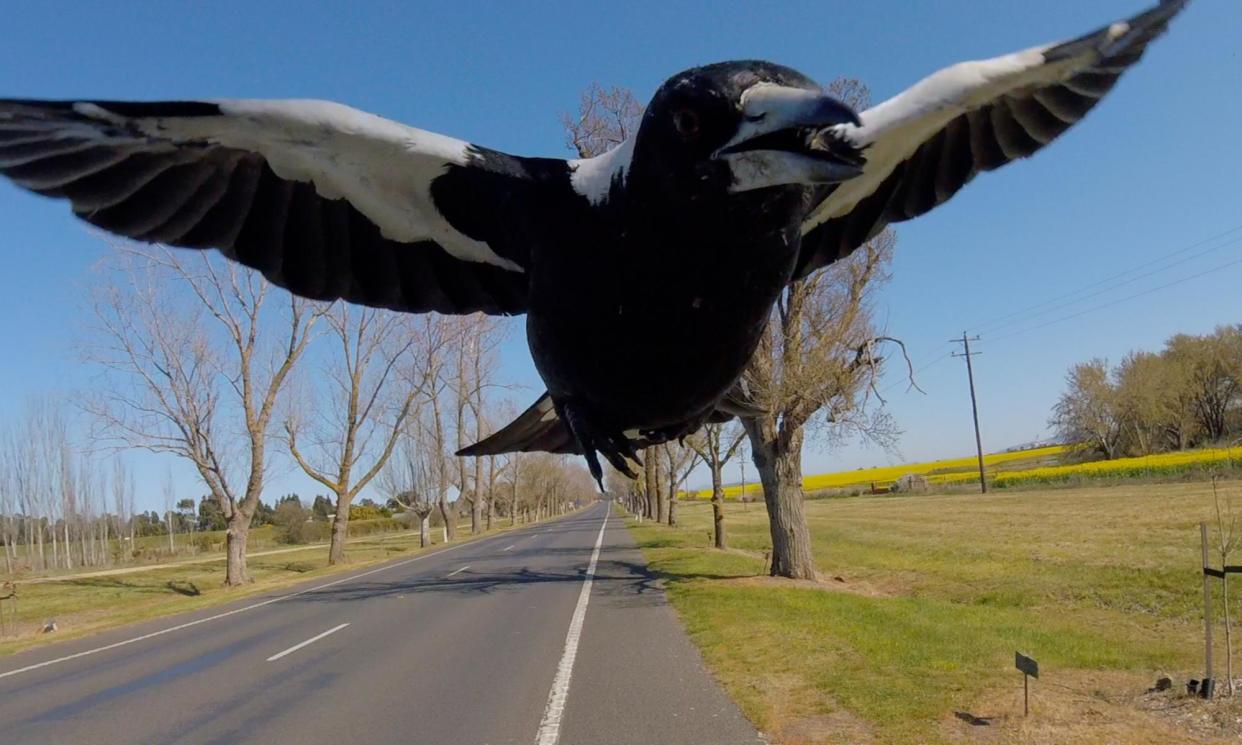Magpie-swooping season is here. But you can avoid attack – if you play by their rules

Down a gravel track in the backblocks west of Ipswich ride six middle-aged women. Their bikes are black, their shorts and exercise tops nondescript – but strapped atop their helmets are party hats.
“You know those little cone hats you used to wear as a kid?” Christina Slik says. “With the streamers on top and the reflective colouring?”
The women are riding a frontline of the perennial conflict between cyclist and magpie at the height of hostilities: the Brisbane Valley Rail Trail in early spring.
Such is the notoriety of Australia’s black and white songbird here that the local council has taken to providing free holographic anti-swooping tape at various points along the 161km trail.
Related: Why Australia loves magpies, even in swooping season
Slik stocked up on the “scare tape” even before leaving her home in faraway Cairns for the three-day ride. The party hats were an extra touch – part magpie deterrent, part celebration of her partner Deb Qazim’s 51st birthday. The gimmick, though, seemed to do the trick.
“We saw one rider in front who got swooped, that magpie went back to its tree and sat and just watched us pass,” Slik says. “We didn’t seem to have any magpies go near us.”
The noise and reflection of the long streamers flying from the back of their helmets may have protected Slik’s troop – there may also have been safety in numbers.
Perhaps, too, the passerine songbirds appreciated the ceremonial pomp of the party hats.
Bicycle Queensland’s Mike Blewitt rode the trail last October with a mate.
“There were definitely a few magpies,” he says. “But we didn’t experience anything like the grey-faced people riding solo in the other direction warning us of impending doom ahead.”
The University of New England emeritus professor in animal behaviour, Gisela Kaplan, says “there is a lot of etiquette associated with the social behaviour of magpies, a lot of rules”.
People who befriend magpies are often brought into the fold of magpie ceremonies, she adds. A magpie who likes the humans that share its territory, Kaplan says, will sometimes present its offspring to them.
The idea that magpies are aggressive is entirely incorrect
Gisela Kaplan
“This is quite a formal occasion,” she says.
For such an event, a magpie may take perch upon a back deck and warble a song to herald its arrival. The bird will have its young stand in silence beside it. It may then accept an offering of food – but Kaplan cautions people not to feed the chicks directly.
“You do not want to undermine the parent’s authority,” she says. “I would almost say their bird behavioural repertoire is reminiscent of Victorian England.
“Kids can be seen but not heard.”
Herein, contends the author of Australian Magpie: Biology and Behaviour of an Unusual Songbird, lies the key to harmonious human-magpie relations: us learning their rules of engagement.
And much of what you may have been led to believe may only inflame the situation, she says.
“Let’s say you’re at risk of being swooped, and you happen to have an umbrella or a stick on you, and you turn that on them,” Kaplan says.
“That is a declaration of war. You can avoid it simply by stopping and talking to the magpie.”
This placatory approach has worked for Kaplan and many others like her, she says – while in her 25 years of field research in which she has “gone right up close” to plenty of magpie nests and given them plenty of opportunity to do so, she boasts not to have been swooped once.
Further misconception, the bird rescuer adds, are the labels often applied to protective magpie parents.
“The idea that magpies are aggressive is entirely incorrect and the wrong word,” she says.
Magpie v magpie disputes are resolved by “quite complex” but “totally peaceful” negotiations and displays held on the border of two clans – that is to say, by “diplomatic solutions”.
“I wish the world could learn from magpies,” she says.
And, perhaps, even the age-old adversary of the magpie – the cyclist – is adapting.
As highlighted by University of Southern Queensland wildlife science lecturer Meg Edwards in the Conversation, MagpieAlert, a public database of attacks, “indicates cyclists are the number one target”.
Not that many bike riders would not need an academic to confirm the target that seems to fall upon the back of their helmets for the annual swooping season.
Blewitt says a growing number of products and trends are available to protect his tribe from avian attack, from “pie-proof” helmets with mesh protecting vulnerable earlobes, to wide-brim helmet attachments, to the old-fashioned DIY zip-tie approach.
“But from a Bicycle Queensland perspective, we always maintain, just set yourself a safe route,” he says. “That might involve using back roads or bike paths for a period – but the main thing is understanding that it is not forever.”
Related: Duck and cover: swooping season is under way and it’s not just magpies
Peak magpie breeding season usually runs from August to November but swooping season mostly only runs over a four-week period while the female sits on the nest and the male defends his new brood, most often between August and October.
During this time, the danger can be real – it is incredibly rare but people have died in magpie attacks and others severely injured.
Blewitt says, though, the “largest potential for injury” is “losing your cool” and falling off your bike.
“So you might have to take a different route around a troublesome magpie,” he says. “But, you know what? It’s just a couple of weeks.”


